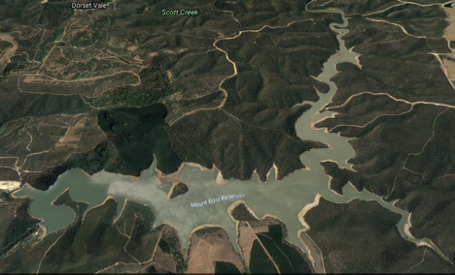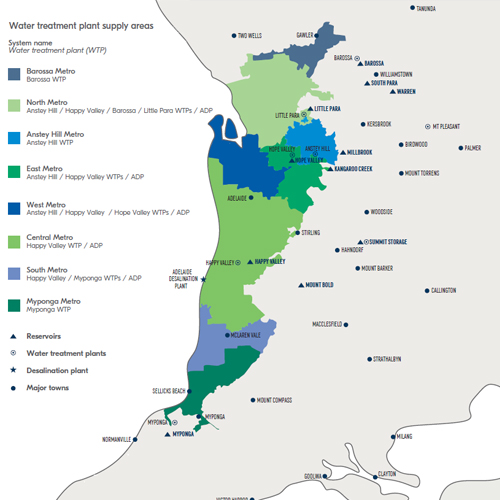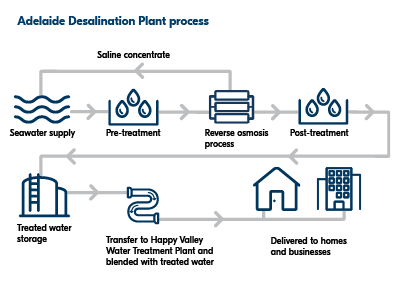As the capital of the driest state in the driest inhabited continent on Earth the security of Adelaide’s water supply now and in the future is of critical importance to us all.
Adelaide’s water supply is a complex network of pipes that draws water from sources including seven reservoirs in the Mount Lofty Ranges, the River Murray and the sea. From the supply source our raw water is pumped through water treatment plants that serve an important role in ensuring clean, safe drinking water. It is then gravity-fed and pumped to over 130,000 homes and businesses within the metropolitan Adelaide area.
The primary responsibility of ensuring Adelaide’s water supply sits with SA Water, a state-owned organisation, employing more than 1,500 people in a range of industries from engineering to microbiology. In the 2018 -2019 Year SA Water collected 46,118 samples from drinking water supplies throughout the state. Overall compliance with the Australian Drinking Water Guidelines for health-related parameters was 100 per cent for metropolitan systems.
Raw Water Source 1: Mount Lofty Ranges Reservoirs
Adelaide’s primary water source is the Mount Lofty Ranges catchment area. The reservoirs catch and store rainfall and stream water as well as water piped from the River Murray. At full capacity the ten Reservoirs located throughout the catchment area can hold almost 200 GL (1 GL = 1,000,000,000L) of water, which is a little less than a year’s supply for metropolitan Adelaide. In order of capacity the main reservoirs in the Mount Lofty Ranges serving Metropolitan Adelaide are
- Mount Bold 46.5 GL
- South Para 44.4 GL
- Myponga 27.6 GL
- Little Para 20.9 GL
- Kangaroo Creek 18.7 GL
- Millbrook 15.7 GL
- Happy Valley 12.7 GL
The remaining three reservoirs Barossa, Hope Valley and Warren all hold less than 5 GL of water each. And while Mount Bold is South Australia’s largest reservoir, water is only released as required to maintain the water level at the Clarendon Weir and, from there, water is diverted to Happy Valley water treatment plant before being supplied to homes and businesses across metropolitan Adelaide.
Raw Water Source 2: River Murray
The River Murray is SA’s main source of surface water supplying metropolitan Adelaide and a number of regional communities. The river makes a key contribution to the water security of more than 1.7 million SA Water customers across South Australia. Of the state’s 87 drinking water supply systems, 37 source water either directly or indirectly drawn from the river, including the five out of seven of the water treatment plants that serve metropolitan Adelaide.
The amount of water drawn from the river varies year to year, depending on the amount of natural inflow into the reservoirs. The river supplements metropolitan Adelaide’s reservoirs via two major pipelines. However, in recent decades during times of drought, it became clear that additional sources of water would be required to secure the future of South Australia’s water supply.
Adelaide’s Fresh Water Treatment Plants
To ensure the safety of Adelaide drinking water all raw water, whether sourced from a reservoir or drawn directly from the River Murray, is treated in one of seven water treatment plants that service metropolitan Adelaide. The treatments plant source water from a combination of locations as follows
- Ansley Hill water treatment plant draws water piped directly from the River Murray and from the Millbrook Reservoir
- Barossa water treatment plant draws water piped directly from the Barossa Reservoir. To match demand Barossa reservoir can pipe in water from two additional sources: the River Murray plus South Para and Warren Reservoirs.
- Happy Valley water treatment plant draws water piped directly from the Happy Valley Reservoir. To match demand Happy Valley reservoir can pipe in water from two additional sources: River Murray and Mount Bold Reservoir.
- Hope Valley water treatment plant draws water piped directly from the Hope Valley Reservoir. To match demand this reservoir can pipe in water from three additional sources – River Murray plus Kangaroo Creek and Mount Bold Reservoirs
- Little Para water treatment plant draws water piped directly from the Little Para Reservoir. To match demand Little Para reservoir can pipe in water from two additional sources: River Murray and Millbrook Reservoir
- Myponga water treatment plant draws water piped directly from the Myponga Reservoir. Myponga is the only treatment plant (serving metropolitan Adelaide) that does not source water from the River Murray.
Fresh Water Treatment Process
In the 2018 -2019 year, compliance with the Australian Drinking Water Guidelines for health-related parameters was 100 per cent for metropolitan systems. SA Water’s conventional water treatment plants typically use a seven-step process
- Coagulation: a chemical coagulant is added to the untreated raw water to dissolve organic material and suspended particles and much of the now dissolved organic matter to create Floc.
- Flocculation: flocculation is a gentle mixing process that gathers together the flocs formed in step 1 to form larger flocs that settle more easily. Water remains in the flocculation tanks for a minimum of 20–30 minutes
- Sedimentation: water and suspended flocs pass slowly through sedimentation basins or clarifiers, allowing most of the floc to settle to the bottom as a sludge. The sludge is periodically removed from the basins for further treatment and disposal. An alternative technique called Dissolved Air Floatation (DAF) is used at the Myponga Water Treatment Plant using fine air bubbles to float floc to the surface forming a sludge blanket, which is removed by overflowing the floatation tanks. Once clarified water continues to the filters.
- Filtration: any remaining floc particles are removed by passing the clarified water through filtration media. The most common filters are deep beds of sand or a combination of sand and anthracite. In newer and smaller water treatment plants, the final filtration step is achieved by forcing the clarified water through synthetic membranes.
- Disinfection: A chemical disinfectant is added to destroy any remaining microorganisms. For Adelaide’s water supply the primary disinfectant applied is chlorine (CL2) gas. In some applications, ultraviolet (UV) light is used to complement chemical disinfection.
- Fluoridation: Fluoride is then added on behalf of the SA Department of Health and Ageing.
- Storage: Drinking water can be stored in storage tanks strategically located to deliver water most effectively during peak usage.
Sea Water Treatment: Adelaide Desalination Plant
Since 2011 the Adelaide Desalination Plant has been using seawater to provide a climate-independent source of water for metropolitan Adelaide and boost the security of the water supply needed to underpin economic and population growth to 2050, supplying up to 100 gigalitres of water per annum, which is about half of the entire states water needs.
The desalination of seawater uses a technology called reverse osmosis which removes up to 99 per cent of the impurities and salt in the water. Drinking water produced in this process is then pumped 11 kilometres via a transfer pipeline to the Happy Valley Water Treatment Plant, where it’s blended with treated water from the reservoir before being supplied to homes in the Central metro, North, South, West and East metro water supply networks.
The plant’s water production capacity is extremely flexible, ranging from as low as 10 percent which allows SA Water to align production with rainfall. When other water sources are plentiful, the service life of the plant is maximised and operation costs minimised, by lowering production. In times of low rainfall and drought production can be increased up to 100% (30ML per day) to ensure Adelaide’s supply of high-quality drinking water.
For around three months each year, drinking water demand is typically low. When there is no need for water production the plant moves to standby mode allowing for maintenance to be undertaken without disruption to water supply.
Water movement throughout the supply system
Much of Adelaide’s water supply is gravity-fed allowing gravity to do the work of moving water to lower points in the system. Where gravity can-not assist water movement – across flat land, uphill or over long distances – we use pumping stations to push it along. SA Water has about 60 pumping stations in the water supply network, built at strategic points to minimise the energy required to move the water.
Keeping a consistent and steady water pressure is important if your water supply is going to be reliable. Even with the use of pumping stations, there are still a range of things that can impact on how quickly the water moves such as how much water is being used and how many connections are on the main. Consistent water pressure is achieved by Pressure Reducing Valves (PRVs) which assist in controlling leaks and pipe bursts, as well as easing pressure problems across the pipe network. SA Water maintains about 50 PRV stations across metropolitan Adelaide.
To secure the future of Adelaide’s water supply the North South Interconnection System (NSIS) allows SA Water to move large volumes of water between the northern and southern water supply systems. The system included the construction of new pipelines north, east, west and south of the Adelaide CBD. Connecting the two systems gives Adelaide a more flexible water system and ensures SA Water can get water to people in times of drought.
Water Supply to Your Adelaide Home or Business
In addition to the water supply network managed by SA Water, home and business owner’s must also take responsibility to ensure access to clean, fresh drinking water by properly maintaining plumbing systems. For all your plumbing needs in the Adelaide area, you can depend on Precise Plumbing Services to help with a variety of general and emergency plumbing tasks, like replacing cracked or broken pipes, pipe relining and clearing blocked drains. We also provide bathroom renovation services. Call today to learn more about our services.











